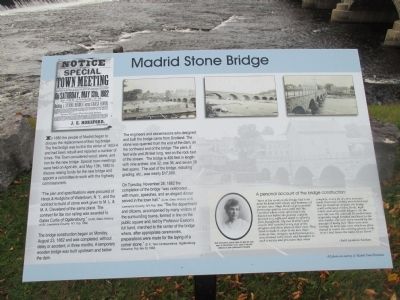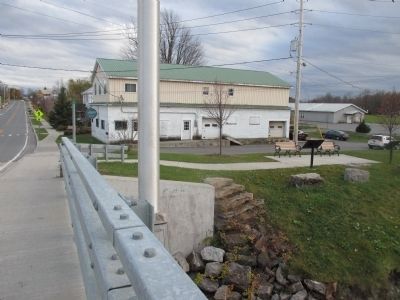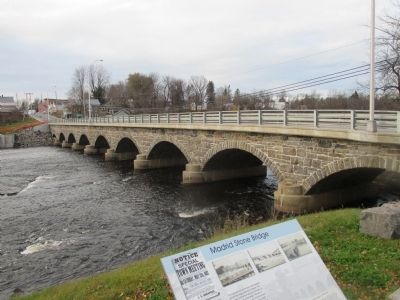Madrid in St. Lawrence County, New York — The American Northeast (Mid-Atlantic)
Madrid Stone Bridge
"The plan and specifications were procured of Hinds & Hodgkins of Watertown, N.Y., and the contract the build of stone work given to M. L. & M. A. of Cleveland of the same place. The contract for the iron railing was awarded to Gates Curtis of Ogdensburg." (Curtis, Gates: History of St. Lawrence County, NY, Pub. 1894)
Notice for Special Town Meeting The Electors of the Town of Madrid will please take notice, and notice is hereby given, that a special Town Meeting will be held at the Town Hall in said Town, On Saturday, May 13th, 1882 at one o'clock, P.M., for the purpose of taking late into consideration the question of building a stone bridge across Grass River, at Madrid Village in said Town, and passing of a resolution instructing the Supervisor of said Town to procure the passage of an Act at the next session of the Board of Supervisors of St. Lawrence County, authorizing him to borrow for and upon the credit of said Town, the sum of Twelve Thousand Five Hundred Dollars, or so much thereof as may be necessary for the purpose of building said Bridge, and to issue the bonds of said Town therefor, and to legalize and confirm the act of the Clerk of said Town in calling this meeting, and the passage of said resolution in regard to a bridge, that may be presented and passed at said meeting. J. E. Horsford,
Town Clerk.
The bridge construction began on Monday, August 23, 1882 and was completed, without delay or accident, in three months. A temporary wooden bridge was built upstream and below the dam.
The engineers and stonemasons who designed and built the bridge came from Scotland. The stone was quarried from the end of the dam, on the northwest end of the bridge. The piers, 6 feet wide and 26 feet long, rest on the rock bed of the stream. The bridge is 400 feet in length with nine arches: one 32, one 36, and seven 38 feet spans. The cost of the bridge, including grading, etc., was nearly $17,000.
On Tuesday, November 28, 1882 the completion of the bridge "was celebrated...with music, speeches, an an elegant dinner served in the town hall." (Curtis, Gates: History of St. Lawrence County, NY, Pub. 1894) "The fire department and citizens formed in line on the public square and, led by Professor Easton's full band, marched
to the center of the bridge where, after appropriate ceremonies, preparations were made for the laying of a corner stone." (D. K.: Town correspondence, Ogdensburg Advance, Pub. Nov 30, 1882)
Ruth Goodnow, shown here at age 20, was born in December 1873. Later in life she reflects on her childhood on Madrid.
A personal account of the bridge construction: "Most of the work on the bridge had to be done by hand with chisels and hammers of various sizes. Huge blocks of grey granite from some quarry were sunk into the riverbed where rocks often had to be blasted out before the granite could be lowered to a sufficient depth to afford a firm foundation. My two brothers and cousin Will watched every step of the progress and drew plans of their own. They tried to make it clear to me how the stone arches, rising to such finished grace, were formed with chisels and hammers to such nicety and precision that when complete, every bit of extra pressure made them more firmly interlocked and that for hundreds of years the bridge could withstand erosion, floods, high winds, and all possible dangers. On the east side was the sidewalk for pedestrians, originally rough finished and hard on the shoe leather, but now worn smooth by the passage of many feet. There were iron railings on both sides over which we often leaned to watch the swirling grasses in the river's bed, hence the name Grass River." ~Ruth Goodnow Keenan
All photos are courtesy of Madrid Town Historians
Topics. This historical marker is listed in this topic list: Bridges & Viaducts. A significant historical month for this entry is April 1826.
Location. 44° 44.802′ N, 75° 7.833′ W. Marker is in Madrid, New York, in St. Lawrence County. Marker is on Bridge Street (New York State Route 345) 0.1 miles north of River Road, on the right when traveling south. Marker is at the south end of the bridge, west side of NY 345, at a viewing area adjacent to the river. Touch for map. Marker is at or near this postal address: 1855 State Highway 345, Madrid NY 13660, United States of America. Touch for directions.
Other nearby markers. At least 8 other markers are within 9 miles of this marker, measured as the crow flies. Madrid Historic Businesses (a few steps from this marker); Dedicated in Honor and in Memory of the Brave Men and Women of Madrid (approx. 0.2 miles away); United Church of Madrid (approx. ¼ mile away); First Presbyterian Church of Dailey Ridge (approx. 3.3 miles away); Pulpwood Grinding Wheel (approx. 6.7 miles away); In Memory of Those Who Made the Supreme Sacrifice (approx. 6.7 miles away); Train Wreck (approx. 7.6 miles away); Potsdam Raquette River Walk (approx. 8.8 miles away). Touch for a list and map of all markers in Madrid.
Credits. This page was last revised on June 16, 2016. It was originally submitted on December 9, 2014, by Anton Schwarzmueller of Wilson, New York. This page has been viewed 361 times since then and 15 times this year. Photos: 1, 2, 3. submitted on December 9, 2014, by Anton Schwarzmueller of Wilson, New York. • Bill Pfingsten was the editor who published this page.


